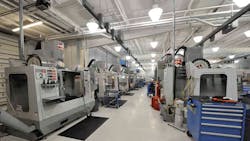With increasing regional and global competition and new demands from customers for lower prices and higher service levels, manufacturer profits are under intense pressure. As a result, OEMs and suppliers are investing in product-cost management and looking at every opportunity to reduce product costs without sacrificing quality. There is a strong desire to understand and control product cost variables, especially larger expenses like tooling. Any company that makes or buys engineered components is likely to spend significant sums on tooling – tens, hundreds of millions, even billions of dollars per year. Ask any manufacturer in automotive, industrial equipment and consumer goods manufacturing; they know that tooling has a significant impact on their bottom line.
The Need for Visibility and Control — For years, many manufacturers put very little scrutiny on tooling budgets - partly because tooling costs were sort of a mystery. Quotes for tooling were (and often still are) very high level, broken down only by material and labor costs. Very little detail is made available and there are few cost standards to compare tooling costs against. Manufacturers just didn’t (and still don’t) have many valid reference points. The information they did have often depends on a few individuals or suppliers with specific tooling expertise. And these benchmarks may even vary quite a bit. All this has made it difficult to compare and assess whether tooling costs are right or not. As a result, most manufacturers simply absorb tooling costs and focus their product cost savings efforts on more predictable and measurable areas.
This is changing though. With the increased pressure on profitability and cost management today, OEMs and suppliers are taking a closer look at tooling costs. They want to make sure the prices they are being charged are valid and are requesting more detail on tooling estimates from internal costing experts as well as suppliers. But this greater degree of granularity requires better, easier to use methods to estimate the costs of tooling; systems that can be used by both tooling experts and non-experts.
Not surprisingly, the cost pressures make their way downstream in the supply chain as well. Tier 1 and Tier 2 suppliers responding to RFQs from OEMs are also being challenged to provide greater detail about tooling costs. It’s a time-consuming process that is being done manually today with homegrown, template type solutions developed in MS Excel or similar database applications.
Compounding the problem is that an individual must have great expertise in costing and tooling to develop a quote. Usually, a company has a handful of different individuals generating quotes who may be using different estimation methodologies, creating even more inconsistency. Suppliers are looking to automate and accelerate this process so that they can respond more quickly and accurately to RFQs and ultimately drive increased revenues.
Evaluating, Selecting, Estimating
To manage tooling costs effectively, designers, cost engineers, sourcing professionals and suppliers need to be able to quickly and precisely determine the cost of tooling for any given product or part. They also need to be able to standardize the tool estimating process to ensure consistency and set cost benchmarks for future reference. At the same time, they can’t give up control. The cost of manufacturing a product or tool in one factory or region may be different than another. Machine and process capabilities may be different. If manufacturers are really going to understand their tooling costs, they need to estimate costs in a way that reflects the unique capabilities of their specific manufacturing environments.
Manufacturers also need the ability to generate highly detailed cost estimates on components for both injection molding and stamping processes. But, beware of systems than only tooling experts can use. Some capabilities to look for include:
• Calculating tooling costs a very detailed level from just a 3-D CAD model.
• Detailed tooling Bill of Materials (BoM) with information on:
- Physical characteristics of the tool (e.g., part size, mold size, material weight, actions, lifters, number of drops, etc.)
- Materials and purchased items used in the tool (e.g., core & cavity plates, ejector box, actions and inserts, stopPins, EDM carbon, etc.)
- Labor and machine times (design, machining, assembly, finishing, tryout, labor hours by process, CMM inspection, etc.)
• Automated tooling estimates each time a component is cost. This will provide non-tooling experts with quick access to precise estimates in real-time.
• A highly detailed, first-pass tooling estimate generated without the user requiring any knowledge of, or expertise in tooling. This enables fast, efficient, and accurate responses to requests for rough estimates.
• Automated bulk costing supports with a wide range of user inputs, or predefined ‘process setup options’ or defaults give the ability to cost the tooling of many parts very quickly.
• Refinement tools for final adjustments by tooling experts.
• Ability to amortize tooling or account for separately
• Set-up and calibration to specific company, equipment, rates, manufacturing rules and operations for generating a specific plant’s actual costs.
Tooling costs are increasingly an important area of focus for many discrete manufacturers as they look for new opportunities to cut product costs without sacrificing product quality. The challenge has been the lack of effective tools to provide the necessary level of detail to truly understand those costs and how to impact them. For OEMs and Tier 1 and 2 suppliers, evaluating solutions to manage and estimate tooling costs, it is very important to standardize the process without limiting the ability to reflect the unique capabilities and characteristics of your specific manufacturing environments. Look for solutions that can work with your 3-D CAD system. The more visibility into costs early on in the process, the easier it is to reduce costs, streamline decision-making and accelerate time to market.
Julie Driscoll is responsible for strategic product and marketing direction for aPriori, Inc., a position that involves identifying new-product cost savings opportunities for discrete manufacturers. aPriori develops software for manufacturing organizations that performs real-time product-cost assessments, from design through production. Contact her at jdriscoll@apriori.com, or visit www.apriori.com

